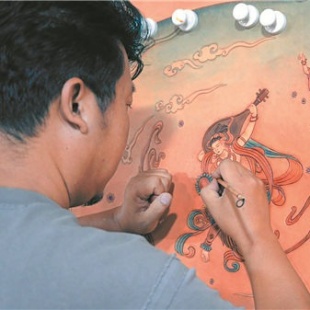Leather art connects past and present


By the Qing Dynasty (1644-1911), Mongolian leather products incorporated more decorative elements, with techniques, such as embroidery, applique, and inlay used to adorn leather items with coral and silver ornaments.
However, after the Qing Dynasty, Mongolian leather carving began to decline.
Part of the reason, according to Jia's observation, was modern lifestyles leading to less demand for leather products and mass-produced industrial items elbowing out manual products.
However, his fate was sealed when he witnessed, as a young child, his father, also a herdsman, making clothes and other items from leather.
He still remembers his grandfather producing leather paintings.
"It feels like part of my home," Jia says.
In his opinion, locals are showing their love and respect toward friends and nature by creating art on leather.
After finishing his studies at a local art school in the early 2000s, Jia decided to carry forward the art, especially when he noticed the country is putting a premium on protecting intangible cultural heritage.
"I'd like to tap into what my ancestors have been doing," he says, adding that the materials involved are abundant in the region and readily available to him.
He has long noticed many daily items on the grasslands bearing leather painting elements, such as saddles and boots.
"They were both beautiful and practical. However, they were not particular about material selection, the workmanship was rough, and they had an unpleasant smell, leading to a decline in their popularity," he says.
Having an art background, Jia started to restore and optimize the traditional craft and explore ways of integrating it with other forms of intangible cultural heritage.
"Leather painting primarily involves carving and inlay on hand-tanned leather, making it a challenging craft," Jia explains.





































